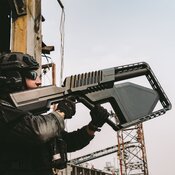According to one financial expert, the return of Donald Trump to the U.S. presidency will not "usher in a new era of global peace and prosperity," even though Trump has vowed to end the war in Ukraine.
"Even as America abandons its European allies, Russia will still have to carry out the gritty task of conquering Ukraine," wrote Jason Simpkins of Wealth Daily on December 3. "That's not going to be easy. Especially for a military that's proven as weak as Russia's."
In addition to President Joe Biden "making an 11th-hour push to give Volodymyr Zelenskyy everything he needs to hold out as long as possible" before leaving office, he said, the U.S. defense budget is approaching US$1 trillion, and NATO Europe has doubled its defense spending in the past 10 years to roughly US$380 billion.
The conflicts in central Asia and the Middle East mean defense spending is expected to rise worldwide, leading to opportunities for investors, experts said. A new ETF created by U.S. Global Investors, the U.S. Global Technology and Aerospace & Defense ETF (WAR: NYSE), aims to help traders get exposure to this shift in wealth.
"The biggest thing is, as we're going into the holiday season, this product (the WAR ETF) is really about protection and defense," Frank Holmes, chief executive officer and chief investment officer of U.S. Global Investors, told newsletter author Jay Taylor in an interview posted on December 21. "Young investors and traders, they relate to playing games like your sons probably did years ago, Minecraft or these other war games. So that's where the idea came from. It's not to go to war, it's to protect us from war."
The fund is set to begin trading on December 30, and major holdings will include Ambarella Inc. (AMBA:NASDAQ), Booz Allen Hamilton Holding Corp., General Dynamics Corp. (GD:NYSE), Hexcel Corp., Nvidia Corp. (NVDA:NASDAQ), and Rhenmetal AG, Taylor said.
"The biggest thing that we have (in the U.S.) is that we're still leaders in technology, and that we're going to continue with that," Holmes said. "People must feel safe, financially, emotionally, and physically. And that's what this product is for."
The fiscal 2025 National Defense Authorization Act called for US$923.3 billion in U.S. military spending, up 4.1% from 2024, according to U.S. News & World Report's Wayne Duggan on December 3.
"The ongoing war in Ukraine; tensions between China and Taiwan; and conflicts between Israel and Iran, Hamas, and Hezbollah may force the U.S. government to increase defense industry investment in the coming years, which could serve as a tailwind for defense sector earnings," Duggan wrote.
Investing in Defense
It's not the first time Holmes has seen an opening and decided to make it lucrative for investors. After being a frequent flyer and seeing airfares go up, he said he created the JETS ETF (JETS: NYSE) to "get some of my money back."
The fund has been a "great success," he said, with companies in the fund doing well, including United Airlines and Expedia, which are up 144% and 25% on the year, respectively.
The success of JETS led him to create a gold ETF centered around royalty companies, GOAU (GOAU: NYSE), which was up 43% this fall from its start at the beginning of 2024.
"I wish my junior mining stocks had done that well," Taylor said.
And now Russia's continuing war against Ukraine has triggered "huge spending" by NATO countries and others, Holmes noted.
"I think under President Trump, we're going to see this button being pushed," he said. "If you don't spend 2% of your GDP on military, then you're not going to be a part of NATO. And that's going to set them straight, and they're going to print the money."
According to Fidelity, an estimated 23 NATO members were expected to spend at least 2% of GDP on defense this year. Poland, on the front line with Belarus and Ukraine, is estimated to spend 4% of GDP this year and has called for NATO to raise its defense-spending minimum target to 3%.
"'Fear trade' of gold is an important asset class in a diversified portfolio, so will be military," Holmes continued.
And in the U.S., the large defense companies like General Dynamics "have big contracts in front of them. They basically have baked-in revenue for the next four years of spending," he said.
Fidelity's Clayton Pfannenstiel, manager of the Fidelity Select Defense and Aerospace Portfolio, said, "The military threat environment is at a level that is incredibly high. … Many nations may continue to respond to rising global uncertainty and risk by controlling what they can — by continuing to invest in their abilities to defend themselves."
Artificial Intelligence Will Play a Big Role
But one new element to the equation that will touch nearly every corner of the military, much like the rest of society, is artificial intelligence (AI), Holmes said.
One of the key components behind the increase in defense spending is fear trade, but it's also AI spending, he said.
According to a report by Markets and Markets, the AI market in the military was estimated at US$9.2 billion in 2023 and is projected to reach US$38.8 billion by 2028 at a CAGR of 33.3%.
"The development of autonomous military systems drives the adoption of AI in the military market," the report said. "The defense forces of leading countries have increased their defense spending to boost the deployment of AI on military platforms."
According to a report by Stockholm International Peace Research Institute (SIPRI) in April 2023, the US, Russia, China, India, and Saudi Arabia collectively accounted for 63% of defense expenditures in 2022.
"Nine major international conflicts have occurred in recent years, including the Russia-Ukraine war, the Saudi Arabia-Yemen conflict, the Syrian Civil War, US-Iran tensions, the India-China tensions, and Armenia-Azerbaijan border conflict," Markets and Markets noted. "Such conflicts result in increased procurement of advanced AI-enabled weapon systems and the incorporation of newer technologies into existing systems to make them more efficient."
AI Expected to Grow at 'Fastest Rate'
The global aerospace and defense market size was worth about US$750 billion in 2022 and is predicted to grow to around US$1.388 trillion by 2030 with a CAGR of roughly 8.2% between 2023 and 2030, Zion research reported.
The industries that design, develop, produce, and maintain airplanes, spacecraft, missiles, and military systems are referred to as aerospace and defense industries. These sectors are essential to the evolution of technology, global economic growth, and national security. While the defense industry is mostly concerned with military capabilities and national security, the aerospace sector has both civilian and military uses.
The aerospace and defense markets are driven by several factors including growing air travel demand, technological advancements, increasing space activities, rising military modernization, and increasing investment in the aerospace and defense industry.
The autonomous defense segment, which includes AI, "is expected to grow at the fastest rate over the projected period," Zion reported.
| Want to be the first to know about interesting Special Situations and Technology investment ideas? Sign up to receive the FREE Streetwise Reports' newsletter. | Subscribe |
Important Disclosures:
- Steve Sobek wrote this article for Streetwise Reports LLC and provides services to Streetwise Reports as an employee.
- This article does not constitute investment advice and is not a solicitation for any investment. Streetwise Reports does not render general or specific investment advice and the information on Streetwise Reports should not be considered a recommendation to buy or sell any security. Each reader is encouraged to consult with his or her personal financial adviser and perform their own comprehensive investment research. By opening this page, each reader accepts and agrees to Streetwise Reports' terms of use and full legal disclaimer. Streetwise Reports does not endorse or recommend the business, products, services or securities of any company.
For additional disclosures, please click here.











































